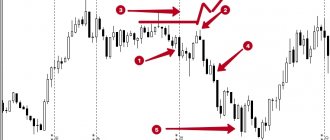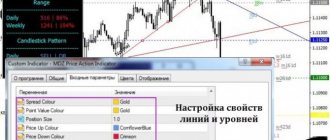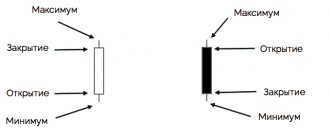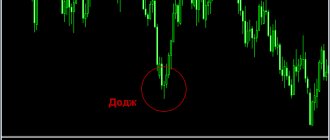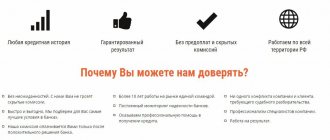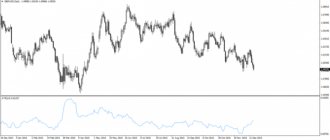The easiest way to determine the market trend is to use candlestick analysis. Any candlestick pattern or figure is the most effective tool for market analysis, helping to forecast the dynamics of the currency market or any financial exchange.
Today, we propose to study in more detail the Hammer and Inverted Hammer reversal formations on candlestick charts.
Candlestick pattern - Hammer and Inverted Hammer pattern. How to identify these patterns on a chart?
In candlestick analysis, there are a huge number of bullish reversal candlestick patterns, but the most common candlestick pattern is the Hammer and Inverted Hammer pattern.
Both figures are reversal patterns, symbolizing in technical analysis a change from a downward trend to an upward trend.
So, how to identify these patterns on a price chart?
The Hammer candlestick pattern is a formation that is a bullish candlestick changing its upward trend, visually similar to a hammer. This type of candle is characterized by a short body and an elongated lower shadow.
Remember - the Hammer pattern is formed exclusively during a downward trend.
If such a formation occurs in an uptrend, it is called a “Hanging Man”.
The candlestick pattern we are considering indicates a local minimum. And here it should be noted that the actual color of the candle’s body does not matter here.
2 BEST OPTIONS BROKERS YOU CHOSE!
No verification required! | review | reviews | START TRADE WITH 10$ Deposit from 5$. New broker! | review | reviews | TRY SIGNALS
RECOMMENDED: THEY REMAIN LEADERS ON FOREX!
| Deposit from 0$. TOP2 strategies | TRADING TERMS | review | reviews Deposit 100$. TOP3 TS. TRADING TERMS | review/feedback Deposit from $1. How to get $1500? TRADING TERMS | review/feedback
The Hammer candlestick figure has the following characteristic features:
the body of the candle is very small, resembling a square in shape; its lower shadow is elongated, usually several times (at least 2) longer than the candlestick body; the upper shadow is absent or very small; a pattern is formed exclusively during a downward trend; the spread in daily prices (minimum-maximum) is very large, that is, the daily spread is an order of magnitude higher, in contrast to nearby candles.
In standard technical analysis, the Hammer formation is used to interpret oversold levels of a traded instrument. This candlestick pattern is a candlestick that confirms the support level and also determines the potential moment of a trend reversal, so the formation belongs to the category of “reversal patterns.”
Hammer pattern in Forex
The Hammer pattern is a reversal pattern, so you can use the Ozymandias indicator to filter its signals.
The strength and relevance of the pattern depend on the ratio of the size of the lower tail to the size of the body of the signal candle:
- If the shadow is too small, then the pattern is unremarkable and should not be considered a strong signal.
- If the shadow is long, and the body of the candle itself is very short, then we are talking about an impulse price jerk. As a rule, such a pattern also gives a false signal in most cases.
To avoid false interpretations, special filters have been created that help distinguish a Hammer reversal from a random price jump. The ratio of the size of the long shadow and the body of the figure should be within 2-3 units. Going beyond these limits in one direction or another violates the setup.
The chart below shows a perfect example of the Hammer. Its body is more than 2 times smaller than the size of a long shadow. The upper tail is very short.
It is desirable that the previous candle, which closed immediately before the hammer, had a small price range. The model will also strengthen if the candle has a white or green body (depending on the terminal), that is, it will be closed by a rise in the quote.
Let's look at the main features of the Hammer pattern (using Japanese candlesticks as an example):
- The pattern formed at the end of a downward trend. Thus, the setup signals the fading and complete weakening of the trend.
- The lower tail of the pattern is long.
- The upper shadow is completely absent or very small compared to the body of the candle.
- The body of the candle is 2-3 times smaller than the lower tail, ideally it should have a regular square shape.
- In appearance, the figure really resembles a hammer.
- During the formation of the candle, high volatility of the quote was observed. This is noticeable if the size of the candle (including wicks) exceeds the size of previous candles.
This pattern signals a change from a downward trend to an upward one. To confirm the signal, you should wait for a bullish (rising) candle to form after the hammer and only then open a bullish trade.
The pattern is a reversal signal only if it is at the end of a downtrend. Therefore, you should not take into account the figures that formed inside the channel from resistance and support lines. In this case, most likely, there will be no reversal and the price will reach one of the boundaries.
The reverse pattern for the Hammer pattern is called the Hanged Man.
The Hammer pattern is often confused with a pin bar, as they are very similar in appearance: both have only one long shadow. But in fact, these models are different. Therefore, we recommend that you familiarize yourself with what a pin bar is and what it looks like.
Reasons for education
Traders starting to trade in the foreign exchange and stock markets are often too lazy to mark price levels on the charts. Because of this, they do not know where the Hammer pattern is most likely to appear.
This happens in the following cases:
- In areas of price support. Most often, these levels are formed where a trend reversal occurred in the past. Asset quotes are influenced by supply and demand; this postulate can be classified as a classic one. Therefore, the trend most often changes direction in the place where it has already happened before. Areas of support can be local, but there are also larger ones.
- When the news comes out. People who have been trading the market for a long time notice that the trend can change quickly. For example, quotes have been falling all day, but then news comes out. If they are positive, then the fall immediately stops. Assets begin to grow. Positive news leads to the formation of a new, bullish trend. At this point you can wait for a pattern to appear.
- The Hammer pattern in candlestick analysis is formed when the price reaches technical levels. Beginners should take into account that when an asset moves, there are the following options: impulses, when the price begins to move along the trend, and corrections. The stronger the trend, the more orders accumulate at the Fibonacci levels. For example, when it reaches 38.2 or 61.8, the daily candle rebounds.
It is useful to mark up the chart in advance; it is best to work with the H4 and D1 time frames. The Hammer and Inverted Hammer candles are clearly visible on them.
Hanged Man pattern on Japanese candlestick chart
The second name of the figure is “Hangman”. This pattern is also called the “twin brother” of the “Hammer” setup, since they are completely similar in appearance. The only difference is that the Hanged Man always appears only at the end of an uptrend, signaling the beginning of a downward trend. Thus, it gives the opposite signal to the Hammer signal.
Appearance of the figure
Signs of the Hanged Man setup:
- The lower tail exceeds the size of the candle body by at least 2 times (but no more than 3 times).
- The upper shadow is completely absent, or makes up no more than 10% of the figure’s body.
- The pattern formed at the end of an upward trend. This suggests that the buyers' strength is running out and the market will soon turn down.
On the chart, the pattern looks something like the one shown in the figure.
Pattern signals
The strength of the pattern signal depends on the length of the lower wick. The longer it is, the more pronounced the signal. However, if the shadow is too long (more than 3 times longer than the body), then this may indicate an unjustified impulse price jump. In this case, it is better to skip entering the deal.
An ideal pattern is one in which there is no upper shadow at all, and the body of the candle has a square shape.
The strength of the Hanged Man signal increases several times if the lower tail of the pattern breaks through the support line. Another reinforcing factor is the presence of a gap (gap) between the “Hangman” and the previous candle. The larger the gap, the brighter the signal.
A confirmation signal for entering the market is the formation of a bearish (downward) candle immediately after the pattern closes. The longer the body of a given candle, the stronger the signal.
You should refuse to enter a trade in the following cases:
- A long bullish candle was formed before the pattern. This suggests that buyers still have enough potential to continue the upward trend. The signal may be false.
- "Maribozu" candle before the pattern. This is an upward candle with a long body and the complete absence of both tails. Under no circumstances should you enter into a trade.
- The figure's body has broken through the resistance line.
Like any other candlestick formation, the Hanging Man pattern cannot guarantee 100% signals for entering a trade. However, in combination with other candlestick analysis techniques, it will help to correctly assess the situation on the market.
Similarities with a pin bar
At first glance, it may seem that the shooting star figure is somewhat similar to a pin bar . But there is a significant difference here - a pin bar must have a body as small as possible, while a shooting star must have it, and of a certain size (no more than ½ the length of the shadow and no less than 1/4).
Therefore, if at first glance it is difficult to understand for some reason, then you just need to carry out the calculation and see how the key indicators relate to each other. Despite the fact that the meaning of the models is the same, there are differences in construction, and for each model the rules are quite strict. Anything that does not fit into the description of one of the models should not be considered a pin bar or a shooting star. All descriptions were compiled for a reason and were repeatedly checked against history.
It is also worth noting that the pin bar is usually traded over short periods, that is, even five minutes can be seriously considered. As for candlestick models, here we at least use a four-hour time frame, and many models generally cannot be considered lower than the daily time frame. But on a daily chart, or, moreover, a weekly chart, a pin bar rarely occurs.
Inverted Hammer Pattern in Forex
The Inverted Hammer pattern is the exact opposite of the Hammer pattern. She has the same small body, but this time it is not the lower, but the upper shadow that is long. Thus, the setup in appearance really resembles a hammer turned upside down.
Signs of the pattern:
- The signal candle was formed at the moment of complete fading of the downtrend, when the forces of sellers were weakened to the maximum.
- The body of the candle is small, square in shape.
- The upper wick is 2-3 times the size of the pattern body.
- The lower shadow is absent or almost invisible.
- The price range of the pattern exceeds the range of previous candles.
The figure signals that after a long downward movement the price will reverse and go in the opposite direction. The signal is strengthened if the body of the pattern is green and the candle that immediately follows it is bullish. In this case, you should open a buy deal.
Market entry and stop loss.
You can place either a stop order to buy 2-5 points above the high of the confirmation candle, or, if you are confident that the price will move up, enter the market. In any case, your stop loss should be 2-5 points below the shadow (low) of the signal candle. This is only a rough guide. In volatile markets, you can move your stop loss further, just like for higher time frames. For example, for a daily timeframe, the stop loss is set at a distance of 5-20 points.
The larger the bullish candle that confirms the Inverted Hammer candlestick pattern, the more likely it is that the price will move higher. However, if this candle is too long, you may have trouble using a reasonable risk-to-reward ratio.
For example, you might want to set a stop loss of 100 pips if the confirmation candle plus the signal candle together add up to 100 pips. Then the estimated take profit will be at least 150-200 points. If the resistance level is within these limits, then the probability of trading is assessed as low and you will have to miss this signal.
Candles and candlestick patterns are the pulse of the market, determining price action ( Price Action ) and the sentiment of market participants, which is the driving force behind price action.
Figure "Shooting Star"
The Shooting Star pattern is completely identical in appearance to the Inverted Hammer pattern. This setup is very easy to find on the chart, which is why it is also one of the most popular patterns among traders.
What does the figure look like?
Signs of the Shooting Star pattern:
- It consists of just one candle, like all previous formations.
- The length of the upper tail is at least 2 times the length of the candle body. At the same time, the wick should not be too long, as this may be a sign of a strong price surge, which will inevitably be followed by a rollback.
- There is no bottom wick, or it is very small.
This figure is formed exclusively at the end of an uptrend and signals a change in the direction of price movement. In this case, the pattern should be located slightly higher than the previous candles and be, as it were, a local maximum that completes the upward trend.
The appearance of the pattern really resembles a shooting star, which is where the name of the figure comes from. Very often, a setup is formed at one of the key levels of resistance or support. If the wick crosses this level, the pattern signal strengthens significantly.
Conditions for entering a trade
To enter the market, you should focus not only on the pattern itself, but also on reinforcing signals that may be on the chart:
- The bottom wick is completely missing. This pattern is much stronger than the one that has a lower shadow.
- A bearish setup is considered stronger than a bullish setup.
- There is a gap between the formed pattern and the previous candle. The larger the gap, the stronger the signal.
- The pattern has formed on the resistance line (but will not cross it with its body).
The confirmation signal will be the candle immediately following the Shooting Star. If it is bearish (red), then the pattern should work out as a plus in 95% of cases. The order should be opened immediately after the close of this confirmation candle.
When is it better to skip entering the market:
- The body of the pattern has crossed the resistance line. It is better not to enter into a trade, as a rollback is possible.
- Before the setup, a large green (bullish) candle was formed with short shadows (or no shadows at all) and a long body. Most likely, the market is still in an upward trend and the “Shooting Star” only speaks of a temporary correction, and not a change in trend.
This figure is a reversal pattern, so you should enter into transactions only at moments when the current trend has already completely weakened. This can be signaled by oscillators, for example, stochastic or RSI. If the price is in the overbought or oversold zone, it means that the current trend should soon change to the opposite.
How to increase profits: 5 practical tips
It is recommended to master any trading strategy on a demo account so as not to risk your own money again. Along with this rule, it is recommended to follow these practical tips:
- You should only work in a trending market: if there was a trend, and then the price began to move in a narrow corridor, you should not open an order.
- Do not trade an hour before or after the publication of important economic indicators - for example, nonfarm or US crude oil reserves.
- Be sure to use technical analysis indicators.
- Consider support and resistance levels. You can build them either independently or using special algorithms.
- Ignore small timeframes below the hourly H1. They give a lot of false signals, which can lead to big losses.
Thus, the Hammer, Hanging Man and other candlestick analysis patterns work quite well on different assets. These are reversal signals, the strength of which increases when certain conditions are met. If you use them together with indicators, you can develop a fairly effective strategy for medium-term transactions (for several hours or days).
We recommend that you familiarize yourself with another candlestick model - the “Rails” pattern, its features, structure and signals. Let us recall that this pattern consists of two candles that have bodies that are almost identical in length and have very short shadows (or no shadows at all).
See also the video on the topic of publication - “Hanged Man” pattern and “Hammer” figure + their reverse versions “Inverted Hammer” and “Star”
Previous
Baracude volume indicator for determining horizontal volumes
Next
Discipline indicator for determining trend reversals
I recommend reading:
- Woodies CCI indicator, its patterns and main signals
- Ozymandias indicator for finding a trend
- QQE - indicator for determining trend and flat on the chart
- Discipline indicator for determining trend reversals
- Standard deviation indicator for determining the trend
- Pulse Flat indicator for determining flat and trend
- Trading against the trend: strategies and rules for opening trades
- Trend strategies for Forex
- Trading strategies on m15 for Forex
- Forex volatility indicators
- Macd + Stochastic strategies for Forex
- TPO Range indicator for Forex trading
- Large time frame in Forex and BO: indicators and strategies
Features of the Forex candlestick figures “Hammer” and “Star”
These patterns differ from other reversal patterns in that they consist of only one candle. They are applicable in the stock and foreign exchange markets. However, there is a difference that in the stock market, gaps between candles appear much more often than in the foreign exchange market. When trading Forex, this situation occurs extremely rarely, and then usually only at the moments when the trading week ends and the weekend begins.
For example, if the gap between the pattern and the previous candle is 20 points, this could mean that the price went down 120 points and up 100 points during this time. It is precisely because of the presence of such gaps that it is best to trade using these patterns on a timeframe no smaller than h1. At lower intervals, many false signals will appear on the charts.
For an additional filter, you can install oscillators or other trend tools on the chart, or regular moving average lines that will show the direction of the trend.
The Hammer, Inverted Hammer, Hanging Man and Shooting Star reversal patterns are quite common on charts. It is important to be able to correctly distinguish them from each other and open transactions only if there are other confirming factors. Since the patterns are reversal patterns, they can be filtered using any trend oscillator, such as the Color Macd indicator. Then trading based on them will be profitable and will not lead to losses.
Trading by model
Experienced traders often incorporate patterns into their strategies, but beginners are not advised to work with complex trading techniques.
It is difficult to predict in advance to what level the price will move after the trend changes direction. When determining goals, you can focus on price levels, use the Fibonacci grid, or combine Price Action with the Alligator or Stochastic indicator, which can be used to determine the trend, overbought and oversold conditions of an asset.
The Hammer and Inverted Hammer patterns are used in trading as follows:
- You need to wait until the model is completed. You need to enter the market when the next candle opens. If a specialist works on a daily chart, you can enter a little earlier.
- Each candle has a shadow. You can wait until the quotes drop a little within the next candle and then enter the market.
In the second case, the stop can be made shorter. But this entry option is risky because the rise in quotes occurs suddenly. In this case, the trader will miss the moment.
Beginners are interested in how far to place their feet. They are installed so that they are 6-8 points short of the Hammer and Inverted Hammer candles.
How to recognize "Hammer"?
To spot the Hammer or Inverted Hammer, you need to mentally connect the small square to the lower handle-shaped shadow. It can be located both above and below. The name “Hummer” is more familiar to traders, since it is in this form that the term is found in foreign literature and news resources.
The “hammer” can only appear during a downward trend. If the body is light in color, then the trend formation will be upward, in the case of a dark color, on the contrary, downward. If a trader is looking to trade on short time frames, then a light Hammer color may be even better for this because it will be much stronger as a signal. And over long stretches, body color does not play a big role.
It can also be useful when performing simple technical analysis. Using it, you can find out the support level or mark the point at which the trend changed its trajectory.
Features of use
Hammers are easily visible on the chart. But in some cases, the figures can simply be confused with two other models:
- "Hangman";
- "Falling star".
The main thing to remember is that the necessary candles appear only during a bearish trend and nothing else. There is a risk of simply not entering the market if you wait for signals to be confirmed. Therefore, in order not to be at risk, experienced traders use the standard scheme - they leave an order a minute before the end of the formation of a light-colored candle. But if such an opportunity suddenly arises, then the trade is moved to a break-even position.
An important indicator of strength is the size of the candle's shadow. The larger the lower shadow of the Hammer or the upper shadow of the inverted Hammer, the greater the significance of the signal. The next candle on the chart can also be considered a strengthening factor. It is always recommended to wait for at least one more candle to form to prevent accidental formation.
A simple example: a hammer has formed on the chart, and then a growth candle appears, then you can open a bullish option. If there was an increase in the market, and then there is a downward candle, then you should open a downside option. It’s better to wait a little than to rush and lose everything.
